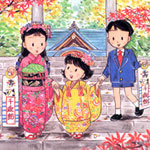 |
Shichi-go-san—literally “seven, five, three”—is celebrated in Japan as a day of prayer for the healthy growth of young children. In most regions around the country, boys and girls aged three, boys aged five, and girls aged seven visit a Shinto shrine with their parents. Most girls wear kimonos when making their Shichi-go-san visit, while boys wear haori (a short, kimono-style jacket) and hakama (skirt-like trousers or cullotes); in recent years, however, as indicated in the illustration above, an increasing number of children are wearing Western-style dresses and suits.
Following the visit to the shrine, parents generally give their children chitose-ame (“longevity candy”). This candy is shaped like a stick and comes in a bag decorated with cranes and turtles, symbols of longevity; both candy and bag are expressions of parents’ wishes that their children should lead long and prosperous lives.
The modern observance has evolved from medieval times, when aristocratic and samurai families celebrated rituals of passage in the following ways:
| • | Boys and girls aged three stopped having their hair shaved and were allowed to let it grow. |
| • | Boys aged five wore hakama for the first time in public. |
| • | Instead of using cords, girls aged seven began using an obi sash to tie their kimono. |
By the Edo period (1603-1868 CE), these practices had spread to commoners, who began visiting shrines to have prayers offered by priests on their children’s behalf. The Shichi-go-san customs followed today evolved in the Meiji era (1868-1912 CE). According to the traditional Japanese calendar, 15 November is considered to be the most auspicious day of the year; because this is not a national holiday, most families visit the shrine on the weekend just prior to or after this date.